Introduction
The engine is what the heart is to a human being. An internal combustion engine is an engine that utilizes the charge ignition of gas to thrust a putt-putt within a cylinder. The movement of the putt-putt makes the crankshaft to revolve and this turns the wheels of the car through a drive rod. Mostly, an internal combustion engine works with petrol, diesel or kerosene (Bellis, n.d.).
History of Internal Combustion Engine
In 1680, Christian Huygens, a Dutch scientist, sketched but did not create an internal combustion engine that would utilize gunpowder as its fuel (Bellis, n.d.). In 1807, another expert from Switzerland, Francois Isaac de Rivaz, created the first internal combustion engine that thrived on a concoction of hydrogen and oxygen as its fuel (Bellis, n.d.). He went ahead and created an automobile for his engine but failed in the design (Bellis, n.d.).
In 1824, an engineer from England known as Samuel Brown took in a second hand Newcomen steam engine to ignite the gas, which he used to energize an automobile up to the hill in London (Bellis, n.d.). In 1858, Jean JosephEtienne Lenoir, an engineer from Belgium, came up with a double-performing, voltaic-ignition internal combustion dynamo that used coal for fuel. In 1863, he attached an enhanced dynamo with petrol based and basic carburetor to a wagon (Bellis, n.d.).
In 1862, a civil engineer from France, Alphonse Beau de Rochas, obtained a patent but failed to create a four-stroke dynamo (Bellis, n.d.). In 1864, Siegfried Marcus created a one-piston dynamo with a basic carburetor (Bellis, n.d.). George Brayton, an Engineer from America, created two-stroke kerosene propelled dynamo, which failed utterly though the engine was the first pragmatic engine (Bellis, n.d.). Later on, in 1866, two German engineers called Eugen Langen and Nikolaus August Otto built on the engines designed by Lenoir and de Rochas and created a more deft fuel engine (Bellis, n.d.).
A sort of breakthrough happened in 1876 when Nikolaus August Otto came up and obtained a patent for a successful four-stroke dynamo called the Otto cycle. In the same year, Sir Dougald Clerk invented the first successful two-stroke engine (Bellis, n.d.). further enhancement of the four-stroke engine happened in 1883 when a French engineer called Edouard Delamare-Deboutville crafted a single-putt putt four-stroke engine that used stove gas for its fuel (Bellis, n.d.).
In 1885, Gottlieb Daimler conceived the first form of the modern day gas engine fitted with a vertical piston, and fuel injected by way of a carburetor with a patent dated 1887. He later created an enhanced four-stroke dynamo (Bellis, n.d.).
Gasoline Engines
A gasoline engine is an engine in the group of internal combustion engines that produce power by igniting a combustible liquid fuel with such ignition started by a voltaic spark (Encyclopaedia Britannica, 2013). These types of engines have the following advantages. They are very deft as they are easy to refuel, less expensive, lighter in weight, have fewer emissions and are thus environment-friendly (WHATGAS.Com, 2013).
Also, gasoline engines start during cold weather with a lot of ease as gasoline is very volatile (WHATGAS.Com, 2013). Compared to other types of engines, gasoline engines are less noisy and generate fewer vibrations in comparison to diesel engines (WHATGAS.Com, 2013). Gasoline engines have a better combustion rate not to mention their smooth acceleration. Generally, their performance is high-powered (WHATGAS.Com, 2013).
In addition to the above advantages, gasoline engines have technical advantages as well. They exhibit low compression ratio, have manifold induction, external mixing and proper control of mixture (WHATGAS.Com, 2013).
Their disadvantages are few compared to the advantages. Gasoline is usually expensive compared to other fuels (WHATGAS.Com, 2013). Secondly, where there is a wrong mixing of oil, the engine will certainly fail to function (WHATGAS.Com, 2013). Gasoline engines have a shorter life than diesel engines.
Below is a diagram of a gasoline engine
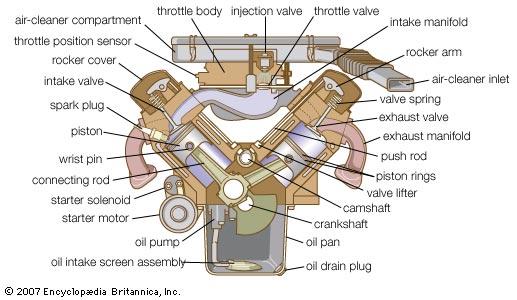
Gas Engines
Though known by a different name, gas engines have several similar features with the gasoline engine and have very slight differences (Encyclopaedia Britannica, 2013). Regarding the structure of the two, the disparity is primarily in the use of a gas-mixing valve instead of a carburetor (Encyclopaedia Britannica, 2013). Otherwise, the cylinder and the putt-putt configurations are similar (Encyclopaedia Britannica, 2013).
Gas engines have their advantages and disadvantages too. Their advantages include the fact that gas engines come with cost-efficient enhancements in automobile fuel economy with a marked fuel economy gain of between 20 and 30 percent (WHATGAS.Com, 2013). They are very environment-friendly, as they do not require controls for the harmful production of oxides of nitrogen (WHATGAS.Com, 2013). Gas engines are the most effective engines when compared to any other engine (WHATGAS.Com, 2013).
They have several advantages that mostly arise from their availability or lack of it. They are yet to be produced en mass and structures for refilling are yet to be availed (Encyclopaedia Britannica, 2013).
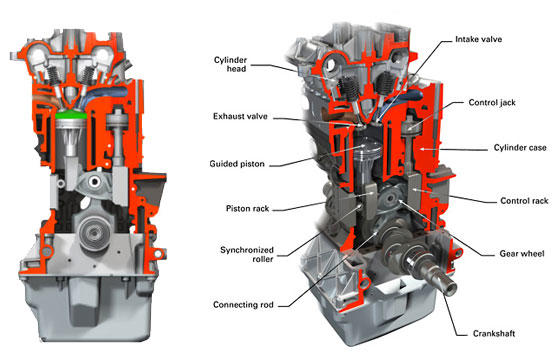
Oil Burning Diesel Engines
These are the type of engines in which oil is put into the fuel line for mixing up with diesel and consequent combustion in the chamber (Nguyen, 2011). The main advantage of these types of engines is that they improve the quality of the engine (Nguyen, 2011).
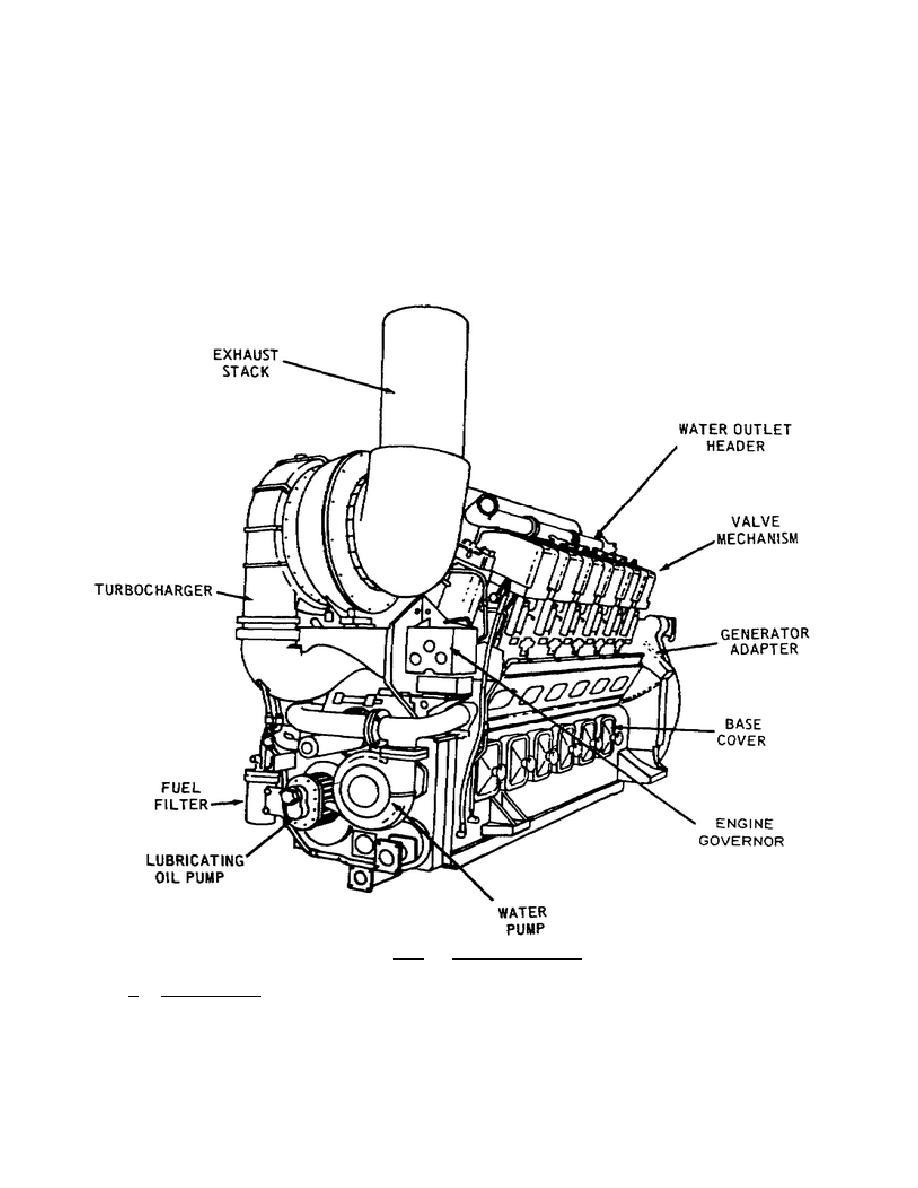
Gas Diesel Engines
Gas-diesel engines are yet to be availed in the market. However, a prototype is in place with the aim of taking advantage of great fuel effective technologies inherent in diesel engines but taking care of harmful emissions. (Nguyen, 2011). The greatest disparity between gas diesel engines and diesel engines is the mechanism used to burn the fuel (Nguyen, 2011).
As such, the prototype is yet to be availed but the structure of the engine will remain almost like the normal diesel engine shown below. Their greatest advantage is the increased fuel efficiency and due to the utilization of gas (Nguyen, 2011). Their disadvantage is the fact that they are yet to be produced en masse (Nguyen, 2011).
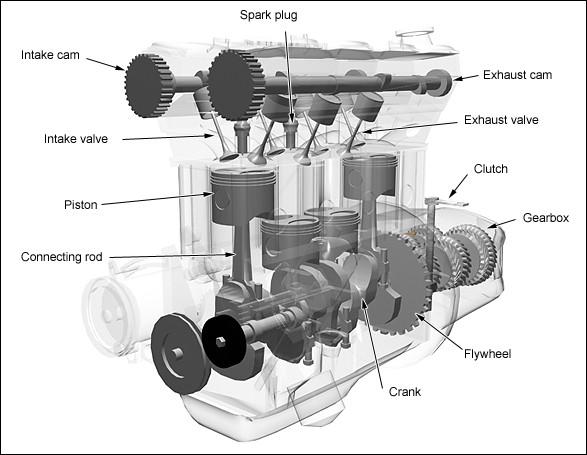
Dual Fuel Diesel Engines
These engines use both natural gas and diesel fuel at the same time. In the process, natural gas burns more compared to the diesel (Dual Fuel Organization, n.d.). Diesel takes the place of a spark plug as it automatically burns under pressure and then burns the gas. The utilization of diesel affords retention of the diesel (Dual Fuel Organization, n.d.). Natural gas gets into the burning chamber by either mixing it with the airflow or introducing it into the chamber (Dual Fuel Organization, n.d.).
Dual fuel diesel engines have several advantages as well as disadvantages. Enhancement of fuel economy is evident as diesel is substituted by between 50 and 80 percentage points and this renders the engine even more powerful (Dual Fuel Organization, n.d.). Dual fuel engines maintain cool temperatures and changing between full diesel and the dual fuel mechanism does not lead to any power loss. (Dual Fuel Organization, n.d.). Dual fuel technologies lead to a longer engine life bearing in mind that gas is a better and cleaner fuel. Oil and filter are rarely changed (Dual Fuel Organization, n.d.).
Just like normal diesel engines, the dual fuel diesel engines produce more vibrations hence the destruction of the body (Dual Fuel Organization, n.d.).
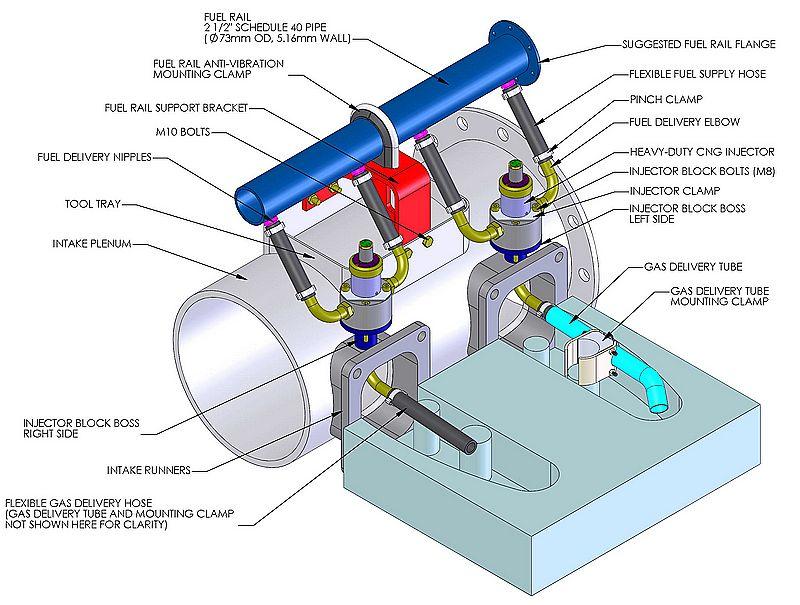
Key Elements and Components of an Internal Combustion Piston Engine, Their Materials, and Function
The key elements of internal combustion under this discussion are cylinder block, combustion chamber, pistons, connecting rod and crankshaft, valves, pushrods, rocker arms, flywheel, and spark plugs (Encyclopaedia Britannica, 2013).
The cylinder block is the main component of an internal combustion engine whose main function is to act as the structural skeleton of the engine and bares the mounting pad, which holds the engine in the chassis (Encyclopaedia Britannica, 2013). A cylinder block is usually a casting with suitable automated surfaces and holes for hanging the cylinder head, main bearings, oil pan among other units (Encyclopaedia Britannica, 2013).
Size, locality and the place of the piston within the cylinder define the combustion chamber (Encyclopaedia Britannica, 2013). The materials used for the construction of the chamber must be hardy, preferably tungsten. This is where the fuel is ignited for the production of the needed energy (Encyclopaedia Britannica, 2013).
Pistons are usually cup-shaped cyclical castings made either of steel or aluminum alloy (Encyclopaedia Britannica, 2013). Plain pressure rings at the top side of the piston prevent the burning gases from going past the pistons (Encyclopaedia Britannica, 2013). Lower rings limit the quantity of lubricant on the cylinder surface (Encyclopaedia Britannica, 2013). Connecting rods are made of steel and their main function is to join the piston to a throw of the crankshaft (Encyclopaedia Britannica, 2013). They convert the alternating movement of the putt-putt to the revolving movement of the crank (Encyclopaedia Britannica, 2013).
The flywheel is made up of a heavy cylindrical cast-iron disk with a hub for strapping to the dynamo (Encyclopaedia Britannica, 2013). The main function of the flywheel is to make uniform the reciprocating speeding arising from the power impulse and reduction in speed arising from compression (Encyclopaedia Britannica, 2013).
The Operation Principles of a 4-Stroke Petrol and Diesel Engine
As the name suggests, this type of engine has four main operations. During the intake stroke, the entrance valve opens to let in the mixture of air and fuel as the putt-putt goes down (Encyclopaedia Britannica, 2013). The compression stroke involves the closing of the entrance valve as the putt-putt comes up the cylinder pressuring the mixture of air and fuel (Encyclopaedia Britannica, 2013). Before the piston touches the top, a spark plug ejects a spark to burn the mixture. The third operation is the combustion stroke where the piston is pushed down by the force wave of the burning of the mixture (Encyclopaedia Britannica, 2013).
Lastly, the exhaust stroke involves the opening of the entrance valve as the putt-putt goes back while expelling the used gases through the exhaust valve (Encyclopaedia Britannica, 2013).
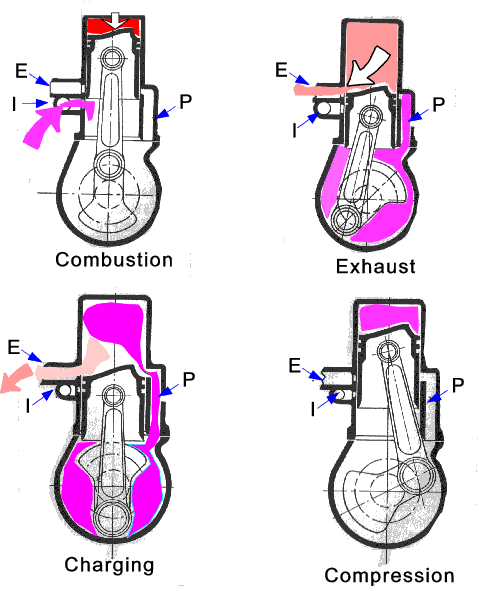
The Operation Principles of a 2-Stroke Petrol and Diesel Engine
In this operation, the putt-putt travels down pressuring the mixture of fuel and air and forcing it into the cylinder. In the process, the burnt gas gets out (Encyclopaedia Britannica, 2013). The mixture is then blown into the combustion chamber through ways in the cylinder surfaces (Encyclopaedia Britannica, 2013). As the piston travels up, a vacuum is created and hence pulls the mixture into the crankcase where a spark lights the mixture and the burning mixture push the putt-putt down and the whole process begins afresh (Encyclopaedia Britannica, 2013).
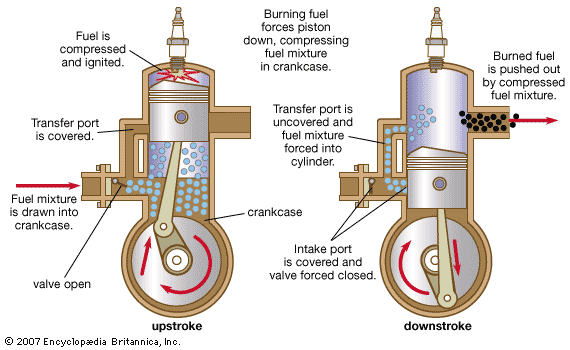
Basic Operating Principles of a Fueling System for a Petrol Engine
The fuel system is made of the fuel tank, whose purpose is the storage of petrol, fuel passages that carry petrol to the carburetor or combustion chamber, a combustion chamber where petrol is mixed with air and an intake chamber to supply the mixture to the cylinders (Encyclopaedia Britannica, 2013). The fuel system also includes oil filters and air cleaners (Encyclopaedia Britannica, 2013).
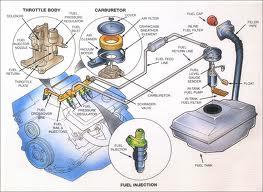
Magneto and Coil Ignition System for Petrol Engine
The main components for the magneto system are a switch, a magneto, a contact breaker, a condenser, great tension supplier and spark plugs (Encyclopaedia Britannica, 2013). The ignition system consists of an electric battery, resistance, lighting switch, ammeter, high-tension coil, contact breaker, condenser and a spark plug (Encyclopaedia Britannica, 2013). Their operations are illustrated in the sketches below
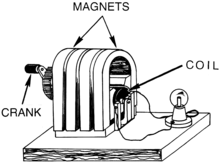
Basic Operation Principle of a Diesel Engine
A diesel engine is quite different from the petrol engine as shown below

Conclusion
Different engines and systems offer different services, have advantages as well as disadvantages. It is proper for a potential buyer and user to understand completely what they want from any system. The concern for the environment must come first before other considerations.
References
Bellis, M. (n.d.). Inventors: The History of the Automobile. Web.
Dual Fuel Organization. (n.d.). Dual Fuel Engines. Web.
Encyclopaedia Britannica. (2013). Gasoline engine. Web.
J., N. (2012). Introduction to Diesel Motors. Web.
Levine, M. (2009). MCE-5’s Variable Compression Gas Engine Promises Power and Efficiency. Web.
Nguyen, T. C. (2011). Gas-powered diesel engine may double fuel efficiency. Web.
WHATGAS. (2013). Diesel or Petrol. Web.
